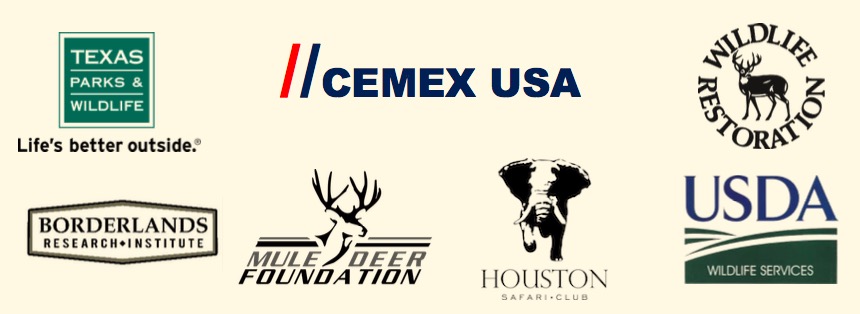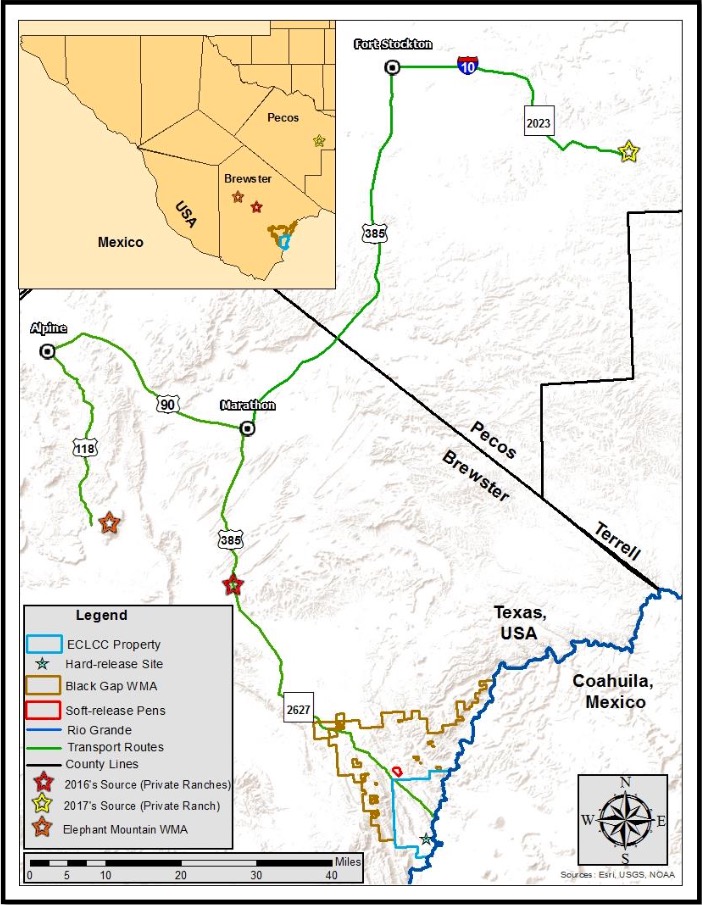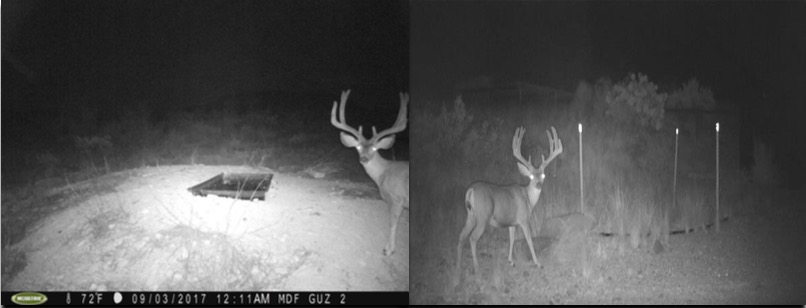Mule deer numbers at Black Gap Wildlife Management Area (BGWMA) and El Carmen Land & Conservation Company-CEMEX USA (ECLCC) (adjacent property) have decreased since the late 1980s and have remained relatively low compared to other areas of the Trans-Pecos; while in the past this area had some of the highest mule deer numbers in the Trans-Pecos. Obviously, drought has significant impacts on Trans-Pecos mule deer populations. However, the mule deer herd within the project area has never rebounded from the last prolonged drought of the late 1990s and early 2000s, when almost all other herds in the Trans-Pecos did. This area also received a second blow to the population with a more recent drought from 2010–2014, which further impacted population growth.

Therefore, objectives of the mule deer restoration project are to (1) conduct a multi-year translocation project to increase the mule deer population within the BGWMA and ECLCC property long-term, (2) evaluate success of restoration effort, (3) monitor mortality and factors that affect survivability, and (4) document movements and home ranges in relation to release sites/methods (hard-release vs. soft- release) and habitat components.
During February 9–10, 2015, we translocated 40 mule deer does from Elephant Mountain Wildlife Management Area (EMWMA) using the helicopter net-gun method (Figure 1). Thirty-four animals were collared with either GPS (16) or VHF (18) radio-collars. The soft-release method was used at BGWMA with 21 does being liberated, while 19 does were hard-released at ECLCC property. One doe died during transport to the ECLCC release site, which was radio-collared.
On February 9–11, 2016, we translocated an additional 75 mule deer does to the restoration area. Twenty does were captured from EMWMA and the remaining 55 does were captured from two private ranches in Brewster County (30 and 25, respectively) (Figure 1). Sixty-two animals were fitted with either GPS (23) or VHF (39) radio-collars. Thirty-five does were soft-released at BGWMA and 40 does were hard-released at ECLCC property.
On February 20–22, 2017, another 98 mule deer does were transplanted to the restoration area. Twenty-seven does were captured from EMWMA and the remaining 71 does were captured from a private ranch in Pecos County (Figure 1). Thirty-two animals were fitted with VHF radio-collars. Fifty- three does were soft-released at BGWMA and 45 does were hard-released at ECLCC property.

Survival
2015-Release: From February 2015 – February 2016 (1-year following release), estimated survival for the 2015-released deer was 64% (Figure 2). Thirteen mortalities were investigated: six from mountain lion predation, one from coyote predation, one capture-related (died in trailer; was not incorporated into reported survival estimate for deer following release), and five from undeterminable causes.
2016-Release: Estimated survival for the 2016-released deer was 76% from February 2016 – February 2017 (1-year following release) (Figure 2). Seventeen mortalities were found: five mountain lion predations, one bear predation, one coyote predation, two capture-related (one died in soft- release pasture, and one hard release area), and eight undeterminable causes. Based on the information gathered, 2016-released deer appeared to have a higher survival rate 1-year following release (76%) compared to 2015-released deer (64%).
2017-Release: The 2017-released deer’s estimated survival is 78% up to August 2017 (26 weeks post-release) (Figure 2). Six mortalities have been examined: two coyote predations, one capture- related (died in soft-release pasture), one pen-related, and two undeterminable causes. Thus far, 2017-released deer appear to have similar survivability as the two previous releases.
Most translocated mule deer mortality (60%) has occurred from April – July (weeks 9–25 following release) (Figure 2), which is the hottest and driest part of the year for this area. Eleven of the 21 mortality events during this time have been caused by predation, primarily mountain lions. In fact, during 2015, mountain lion predation accounted for about 50% of the mortalities. Management of mountain lions in the immediate release area has been conducted when depredations of mule deer were documented. We removed 3 mountain lions from BGWMA during 2015–2016 when these kills were found. Since then, identifiable mountain lion predation has been considerably lower in 2016 (20%) and 2017 (0%).

Preliminary Movements/Home Ranges
Telemetry has been conducted >1×/week either by ground or airplane to help monitor movements and activities of the translocated mule deer. GPS radio-collars obtain locations of the mule deer’s movements every 3 hours, but this data is not accessible until the radio-collar is recovered (either after radio-collar automatically drops off the animal or if the animal dies). Obtaining locations on VHF radio-collared mule deer is either done by getting visuals or estimated locations while conducting aerial telemetry. Estimated locations of radio-collared deer (VHF and GPS) from both release sites were obtained in May 2015, 2016, and 2017 (~3 months following respective releases), September 2015, 2016, and 2017 (~7 months following respective releases), and January/February 2016 and 2017 (~1 year following each release) during telemetry flights.

 Figure 3. Estimated locations of radio-collared mule deer during May 2015–2017 telemetry flights. Maps show only the deer released in the respective transplant year.
Figure 3. Estimated locations of radio-collared mule deer during May 2015–2017 telemetry flights. Maps show only the deer released in the respective transplant year.In May 2015, all 19 deer from the BGWMA release were located; only five of the remaining 12 ECLCC deer were located (Figure 3). The three farthest north locations were from BGWMA deer; they were roughly 25–35 miles north of the soft-release pasture. No flights were conducted over Mexico at this time. In May 2016, 29 of the 30 remaining BGWMA collared deer and 23 of the 29 ECLCC collared deer were located (Figure 3). Two of the BGWMA soft-released deer were approximately 30 miles north of the soft-release pasture and one of the ECLCC hard-released deer was about 50 miles northeast of the release site. Ten of the ECLCC were located in Mexico. In May 2017, we were able to hear all of the BGWMA 2017 collars remaining and 12 out of 15 of the ECLCC deer were found (Figure 3). We heard a total of three collars from 2017 release in Mexico with one being from the Black Gap WMA soft-release. Farthest movements from both release methods in 2017 have been about 30 miles from respective release sites; BGWMA (soft-release) had one individual, whereas ECLCC (hard-release) had two individuals (Figure 3).

 Figure 4. Estimated locations of radio-collared mule deer during September 2015–2017 telemetry flights. Maps show only the deer released in the respective transplant year.
Figure 4. Estimated locations of radio-collared mule deer during September 2015–2017 telemetry flights. Maps show only the deer released in the respective transplant year.During September 2015, 11 of 15 BGWMA collared deer and three of the 10 ECLCC collared deer were located (Figure 4). Most of these deer were either near or within the BGWMA/ECLCC boundaries. In September 2016, 21 of 30 remaining BGWMA collared deer and two of the 29 ECLCC collared deer were located (we did not search ECLCC and surrounding areas at this time) (Figure 4). The furthermost collared deer found was an ECLCC hard-released doe; this doe appears to have made it back to the area she was originally translocated from, approximately 40 miles northwest of the release site. In August 2017, we detected 7 out of the 10 remaining BGWMA collars and 13 of the 15 ECLCC collared deer. Farthest movements were from the soft-release at 36 miles to the northeast near the Rio Grande. No flights were conducted in Mexico.

In January 2016, 13 of 14 BGWMA collared deer and six of the 10 ECLCC collared deer were located (Figure 5). In February 2017, we located 22 of the 30 BGWMA 2016 collars and 15 of the 29 ECLCC 2016 collars (Figure 5). Outermost movements from two ECLCC deer were about 43 miles to the northeast, and one BGWMA deer was about 34 miles to the northeast (Figure 5). Still, the majority of deer located were either near or within the BGWMA/ECLCC boundaries with some residing in Mexico. It seems that the soft-release method may decrease dispersal distances; however, even deer dispersing greater distances appear to be finding good habitat across the landscape. We hope this will lead to better mule deer production/numbers in the future throughout an expansive area, not just the BGWMA/ECLCC complex.
As of August 2017, 29 GPS radio-collars have been recovered from the 2015- and 2016-released deer, collectively. Of the 11 GPS radio-collars from the 2015-release, six were from the BGWMA soft-release and 5 were from the ECLCC hard-release (Figure 6). Of the 18 GPS radio-collars recovered from the 2016-release, 10 were from the BGWMA soft-release and 8 were from the ECLCC hard-release (Figure 7). Many does moved outside of the study site boundaries onto either private, federal (Big Bend National Park), or international (Coahuila, MX) lands (Figures 6 and 7). Based on collar data, estimated flight locations, and ground telemetry efforts, >25 collared deer (all releases combined) have traveled to Mexico at one point in time. The furthest doe located in Mexico was approximately 38 miles southeast of the hard-release site (as of June 2017). The area in Coahuila, Mexico that most deer are visiting and using is part of CEMEX’s El Carmen Project; their land is all under a conservation program.
Interestingly, >4 collared does from the 2015 and 2016 BGWMA soft-releases (one of which had a GPS collar) made their way to a private ranch ~35 miles north. These does originally came from EMWMA. They stayed on the ranch for some time, but ended up returning to the BGWMA area (Figure 6). In 2016, a collared doe from the 2016 ECLCC hard-release also made its way back to this same private ranch (source from which this doe came from). Once she found her original ‘home’, she stayed (Figure 7). This ranch is ~45 miles north of the hard-release site and she returned within 1 month of being released.
From the 29 GPS radio-collars recovered, 20 (7 from the 2015-release and 13 from the 2016-release) have collected >1 year of movement data, and have been used to calculate home ranges for these individual does. Home ranges are calculated using package T-Locoh in Program R. Data has been separated and analyzed by release year (2015 vs. 2016) and release method (soft vs. hard). Although sample sizes are small, preliminary data suggests that there is not a difference between release years, but there is between release methods (Table 1). Statistical tests are still in progress to examine movements, home ranges, and travel corridors. Analyses of habitat selection (using the GPS radio-collar data) are also underway. Results should be completed by December 2017.
Table 1. Home range (acres) calculations (1-year following release) for mule deer does translocated to the BGMWA/ECLCC Complex, Texas, Feb 2015—Feb 2017.
| Release Year/Method | n | Min | Max | Avg. |
| 2015 | ||||
| Soft-release | 4 | 1,028 | 5,718 | 2,906 |
| Hard-release | 3 | 1,490 | 21,718 | 8,560 |
| 2016 | ||||
| Soft-release | 6 | 1,179 | 3,682 | 2,305 |
| Hard-release | 7 | 1,559 | 26,490 | 7,198 |


Mule Deer Population
The mule deer population at BGWMA is trending upward, from estimates of about 250 during fall 2015 to >400 in fall 2016. Mule deer numbers at ECLCC are also increasing because of the transplants. In addition, many translocated does have been observed with fawns during the project’s timeline.
Habitat evaluations conducted in 2014–2016 estimated that the BGWMA/ECLCC area could support more deer with very low utilization rates of important shrub species eaten by mule deer. We believe BGWMA alone can support approximately 1,000 mule deer long-term.
Future Management Actions
Plans are currently underway for the translocation of additional mule deer to the BGWMA/ECLCC area during March 2018. All mule deer will be ear-tagged for their respective release sites and a portion will be marked with GPS radio-collars.
GPS radio-collars will continue to be used to monitor and assess survival, movements, and habitat preference. Timely investigations of each mortality will help us better understand causes of death and potential factors affecting population dynamics of the area. Data from GPS radio-collars will be used to build sample sizes and better analyze finite movements (rates, patterns), travel corridors, and habitat utilization. Sample sizes have been somewhat inadequate to draw concrete conclusions regarding differences between soft- and hard-released deer for each transplant year; therefore, radio- collaring another cohort of translocated animals will provide more information and improve sample sizes.
Predator management efforts will continue to be implemented at crucial times (prior to translocation, fawning season, mountain lion depredations within immediate release) to improve survival.
Thanks!
Because of the many partnerships and generous donations, we are making strides in bringing back mule deer numbers to levels that historically occurred throughout the lower Big Bend Region of western Texas and adjacent northern Coahuila, Mexico.

Download BGWMA-ECLCC MD Restoration PDF
